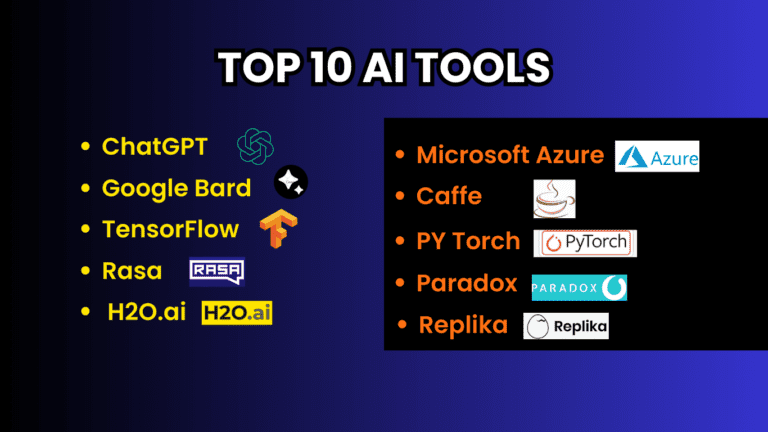Welcome to the future of technological innovation, where artificial intelligence (AI) tools are causing revolutionary shifts across a wide range of industries. We take a deep dive into the dynamic and always changing world of artificial intelligence (AI) in this extensive blog post, highlighting
the top 10 AI tools that are revolutionizing the way we work, analyze data, and make decisions. Get ready to discover the amazing powers inherent in these AI tools, which have unquestionably grown to be essential resources in the contemporary business ecosystem.
As we navigate through the intricate landscape of AI tools, it’s crucial to acknowledge the pivotal role they play in revolutionizing various sectors. From streamlining complex processes to enabling data-driven insights, AI tools have emerged as catalysts for efficiency and innovation.
Now, let’s delve deeper into the intricacies of the top 10 AI tools that are making waves across industries, propelling us into a future where intelligent technologies are seamlessly integrated into our daily operations. Get ready for a detailed exploration of these groundbreaking tools, each contributing uniquely to the tapestry of artificial intelligence excellence.
Table of Contents
Top 10 AI Tools
Artificial intelligence (AI) has changed things by increasing automation and the ability to make decisions and solve problems. To celebrate the first anniversary of our journey around the world, let’s learn about the artificial intelligence tools that play a vital role in this ever-evolving landscape.
These tools not only demonstrate the power of artificial intelligence but also its potential in a variety of applications. At the forefront of ChatGPT, different language models integrate different AI systems for conversations. Google BERT, TensorFlow, Rasa, and H2O.ai have always been able to achieve
this goal, with the aim of applying points to the integrated development of natural language, machine learning, and all conversational platforms. Microsoft Azure, Coffee, and PyTorch are also indispensable for a strong framework for the power of AI.
The aim of this research review is to study the capabilities and footprint of the top 10 AI tools and their changing role in transforming the future of AI.
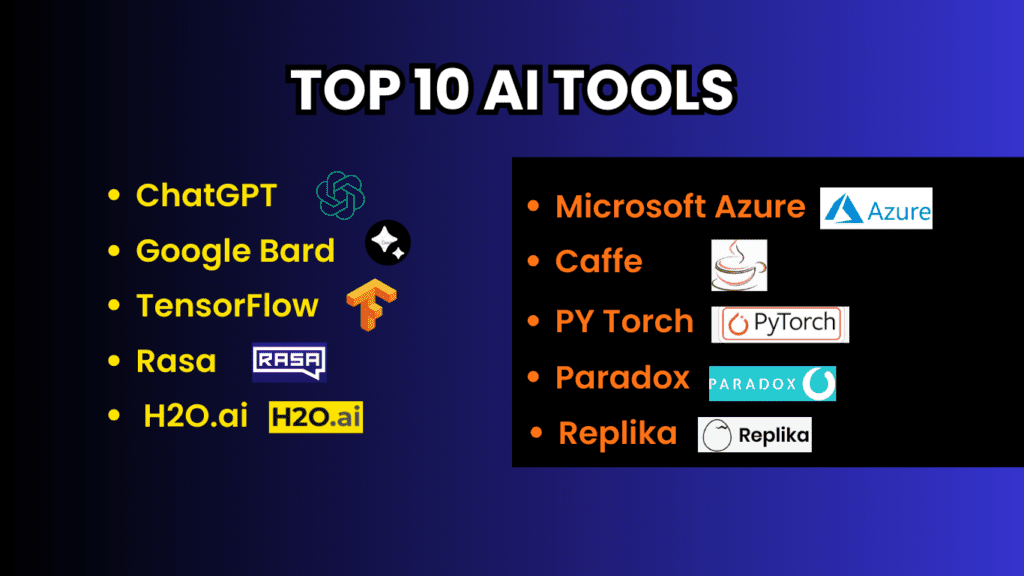
1. Chat GPT: Top 10 AI Tools
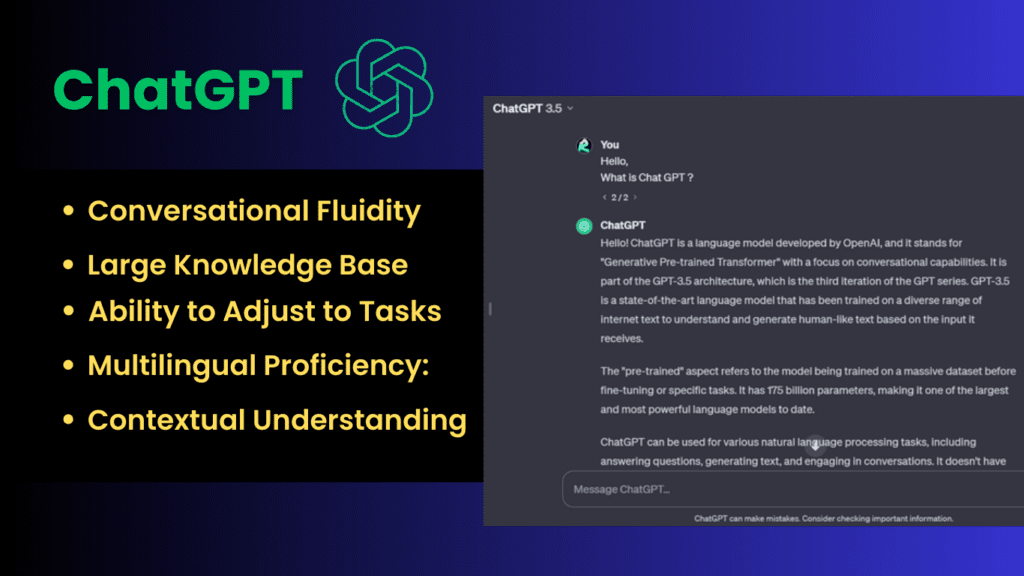
In the then-evolving AI landscape, language models occupied second place, filling the machine as we interact with technology. That’s why ChatGPT stands as the pinnacle of artificial intelligence and is built using the OpenAI-based GPT 3.5 architecture. In this in-depth review, we explore the best of ChatGPT and highlight its features and capabilities that redefine the boundaries of human-computer interaction.
Features of ChatGPT
- Conversational Fluidity: ChatGPT is excellent at interpreting the context of a discussion, enabling responses that are both fluid and pertinent to the context. Interactions with the model feel more engaging and natural as a result.
- Large Knowledge Base: ChatGPT has a large knowledge base because it was trained on a variety of large datasets. It is a flexible tool for users looking for precise and fast answers because it can offer information on a variety of subjects.
- Ability to Adjust to Tasks: Not only can ChatGPT be used for casual chat, but it can also be used for a variety of tasks like writing code, answering queries, creating conversational agents, and drafting emails. Its adaptability makes it a useful tool in a variety of fields.
- Multilingual Proficiency:
With its multilingual features, ChatGPT overcomes the notion that language should be a barrier. It promotes global accessibility by having multilingual comprehension and generation capabilities. - Contextual Understanding: One of ChatGPT’s most notable qualities is its capacity to preserve context throughout longer chats. This guarantees that answers consider the entire history of the conversation in addition to the most recent input.
2. Google Bard: Top 10 AI Tools
First of all,
Greetings from a time of unprecedented technological progress, where the introduction of artificial intelligence (AI) has come to be associated with creativity and effectiveness. In this blog post, we explore the top 10 AI tools that are changing industries and defining the direction of intelligent technologies. In order to better understand these innovative tools, let’s take a closer look at Google Bard, one of the leading names in artificial intelligence
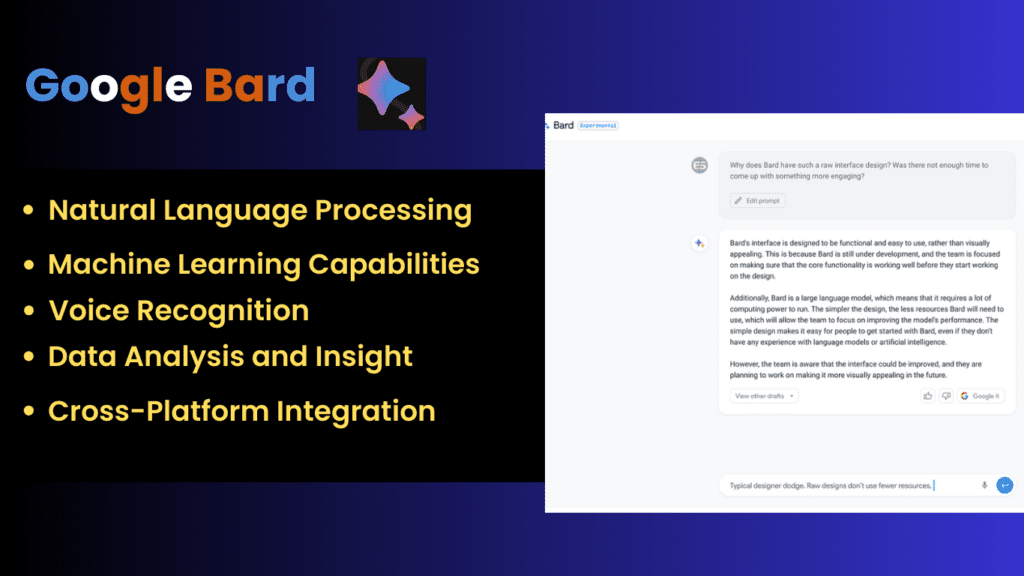
Google Bard: A Leader in AI Performance
With an extensive number of features that add to its widespread praise, Google Bard is a trailblazer in the artificial intelligence space. Fundamentally, Google Bard is a versatile AI instrument meant to improve user experiences and expedite procedures in a range of industries.
The Key Features of Google Bard:
- Natural Language Processing (NLP): Google Bard uses advanced NLP algorithms to process and comprehend human language with astounding precision. By improving communication between users and the AI system, this feature makes the interaction more natural and easy to use.
- Machine Learning Capabilities: Based on user interactions and data analysis, the tool’s robust machine learning abilities enable it to continuously evolve and adapt. By doing this, Google Bard is able to continue leading the way in AI innovation and improve over time to produce ever-more-sophisticated outcomes.
- Voice Recognition and Integration: Google Bard’s powerful voice recognition and integration features are one of its best features. Users of natural voice commands can communicate with the AI tool, opening up new possibilities for hands-free and seamless integration into routine chores.
- Data Analysis and Insights: In addition to processing data, Google Bard is highly skilled at analyzing large datasets to produce insightful reports. The tool is an invaluable asset in decision-making processes because of its data analysis capabilities, which include trend prediction, pattern recognition, and meaningful information extraction.
- Cross-Platform Integration: Users can access Google Bard on PCs, mobile devices, and other linked technologies thanks to its smooth integration across multiple platforms. This adaptability guarantees that the advantages of AI are not limited to a particular setting but instead
3. TensorFlow: Top 10 AI Tools
TensorFlow is a well-known name in the field of artificial intelligence. This potent open-source machine learning framework has transformed the way developers approach model development and deployment, earning a spot among the top 10 AI tools.
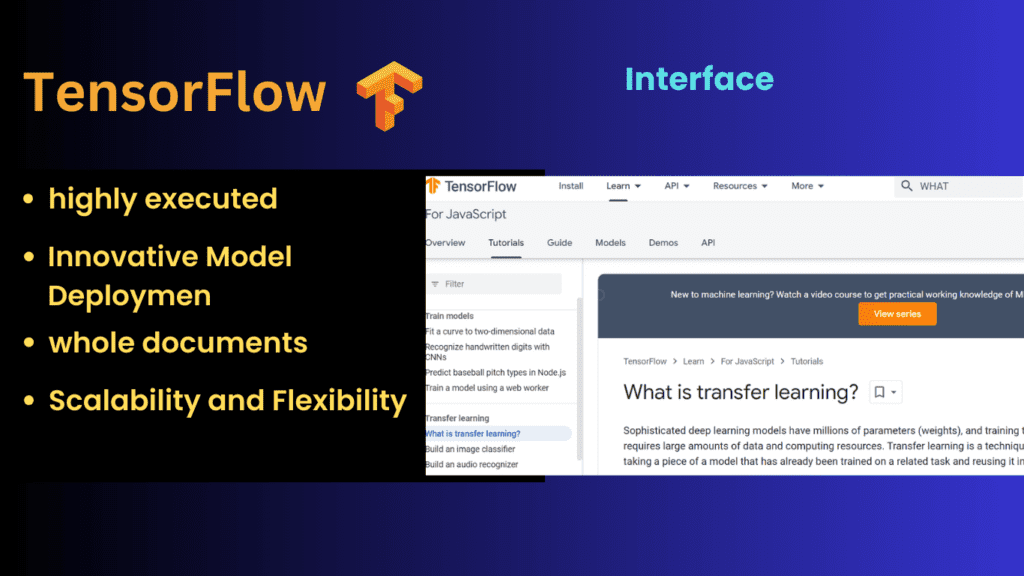
Let’s look at the features that make TensorFlow a valuable tool in the field of artificial intelligence.
Features
- Scalability and Flexibility: TensorFlow’s scalability and flexibility are key features that make it appealing. Developers greatly appreciate its easy scaling from a single device to numerous GPUs and CPUs because it can be used for both small- and large-scale industrial applications.
- whole documents: The vast and well-documented library of TensorFlow offers developers a multitude of tools. The framework’s tutorials and guides make it simple for users to navigate and accelerate the learning curve for those new to the field of machine learning.
- Innovative Model Deployment: TensorFlow’s stable infrastructure makes it easier to deploy models on a variety of platforms, including embedded systems, mobile devices, and web browsers. Its broad acceptance can be attributed in large part to its adaptability.
- highly executed
The eager execution mode of TensorFlow makes model development more dynamic and intuitive. The ability for developers to assess operations immediately speeds up the prototyping and debugging processes.
4. Rasa: Top 10 AI Tools
Welcome to the world of conversational AI, where one of the top 10 AI tools, Rasa, is transforming human-machine interaction. In this investigation, we explore the exceptional qualities that render Rasa a valuable tool for anyone looking to leverage natural language processing.
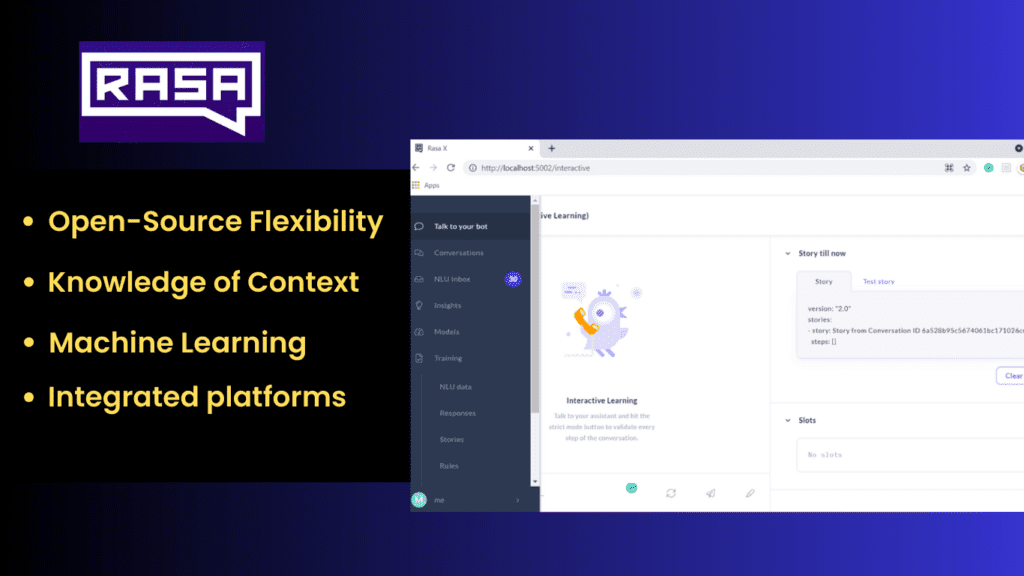
Features
- Open-Source Flexibility: Rasa’s open-source nature is what makes it attractive and sets it apart from the other top 10 AI tools. This adaptability encourages creativity and adaptability by enabling developers to personalize and adapt the conversational experience to their unique needs.
- Knowledge of Context: Rasa’s superior contextual understanding skills put it in the top 10 AI tools categories. It adds a human element to machine-led dialogues by understanding the subtleties of conversations, enabling more engaging and natural interactions.
- Machine Learning-Powered Discussion Management: One of Rasa’s unique features that distinguishes it from the other top 10 AI tools is its machine learning-powered discussion management. Because of its dynamic capability, the system can continuously improve the quality of interactions by learning from and adapting to user input over time.
- Integrated platforms
By integrating easily across multiple platforms, Rasa increases its impact and maintains its ranking as one of the top 10 AI tools. Its compatibility provides a smooth and uniform conversation experience across messaging apps, web apps, and other platforms.
5. H2O.ai: Top 10 AI Tools
Welcome to the unmatched innovation zone, where artificial intelligence (AI) is changing the face of technology. We highlight H2O.ai, a major player in the AI space, in our examination of the top 10 AI tools. Come along as we explore the nuances of H2O.ai, a significant force behind the development of intelligent technologies.

Overview of H2O.ai:
H2O.ai is a revolutionary force in the AI field, not just a tool. H2O.ai, an open-source platform, enables companies and data scientists to realize the full potential of machine learning. The mission of H2O.ai is to democratize AI by making machine learning and advanced analytics available to everyone.
Features
- AutoML Functionalities: H2O.ai uses its AutoML functionality to simplify machine learning. This feature makes it easier for users to navigate the complexities of model development by automating the processes of model selection and hyperparameter tuning.
- Scalability -The capacity is one of H2O.ai’s best qualities. H2O.ai is made to grow with you, whether you’re a startup or an established business working with large datasets. It guarantees reliable performance in a variety of computing environments.
- Explainability and interpretability: It’s critical to comprehend AI decisions. H2O.ai provides interpretability and explainability features, going beyond simple black-box algorithms. Transparency fosters trust and makes decision-making easier.
6. Microsoft Azure: Top 10 AI Tools
Welcome to the future of technology, where Microsoft Azure is a dominant force in artificial intelligence. We highlight Microsoft Azure in this examination of the top 10 AI tools because it has been instrumental in transforming the artificial intelligence space.
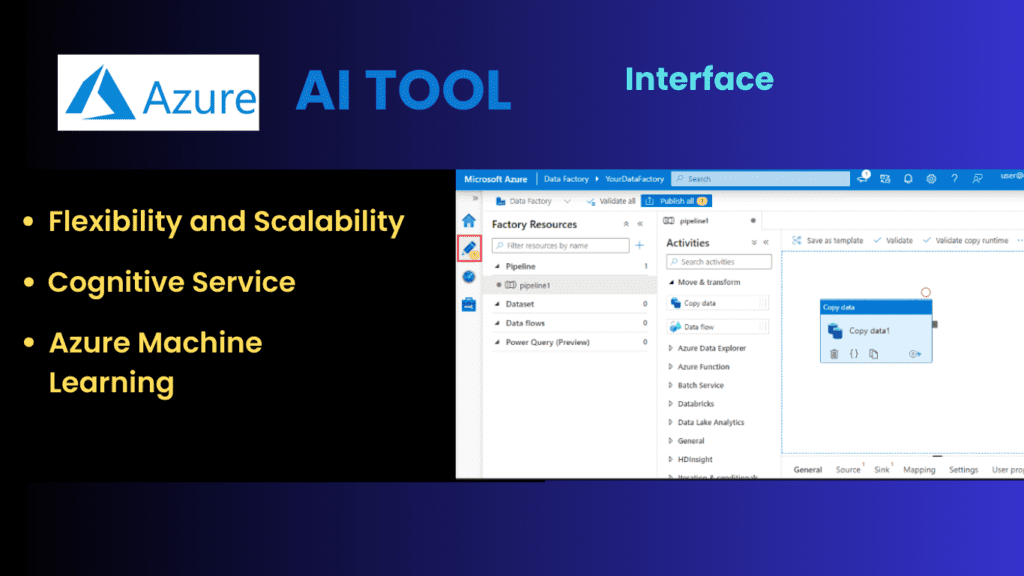
Introduction to Microsoft Azure
Standing tall as a fully-featured cloud computing platform, Microsoft Azure provides a robust set of tools and services that even venture into the realm of artificial intelligence. Azure is clearly present in the top 10 AI tools, and as such, it will have an important effect on how intelligent solutions are developed in the future.
Features of Microsoft Azure:
- Flexibility and Scalability: Microsoft Azure’s unmatched scalability is one of its most notable qualities. Azure’s flexible infrastructure easily adjusts to changing workloads, whether you’re a large enterprise or a startup, guaranteeing optimal performance for AI applications.
- Cognitive Services: One of Azure’s unique selling points is its extensive collection of Cognitive Services, which enable programmers to integrate speech, language, vision, and decision-making into their apps. This broadens the application of AI to a variety of tasks, such as natural language processing and image recognition
- Azure Machine Learning is a valuable addition to Microsoft’s AI toolkit, as it streamlines the entire machine learning process. Azure Machine Learning streamlines the intricacies of creating and implementing AI models, from model development and training to deployment and management.
7. Caffe: Top 10 AI Tools
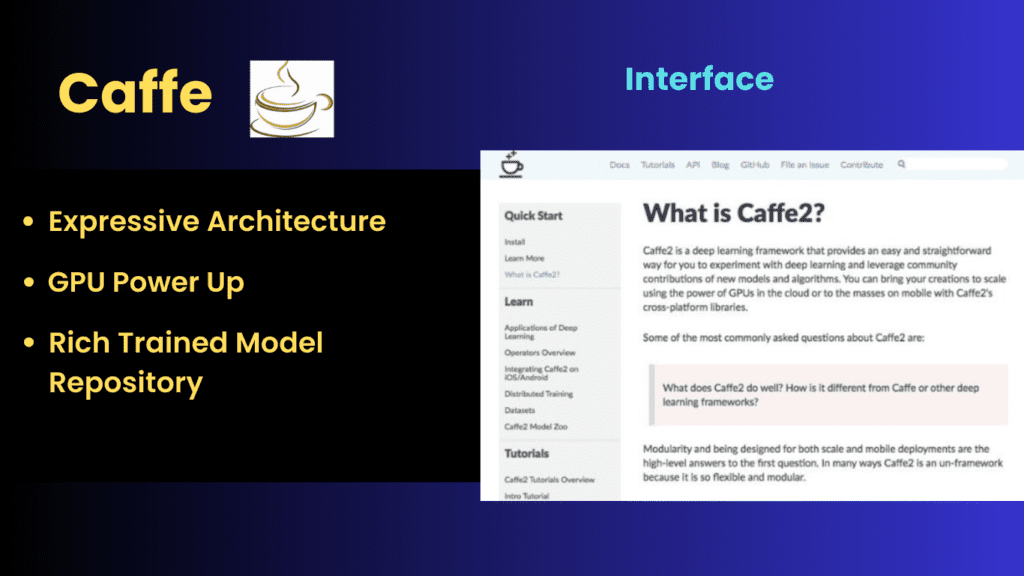
Top 10 AI Tools: Uncovering Caffe’s Innovative Potential
During our exploration of the top 10 AI tools, Caffe’s significant influence was hard to ignore. The convolutional neural network architecture for fast feature embedding, or Caffe, solidifies its status as a pioneer in the field of artificial intelligence. A major turning point in the creation of deep learning frameworks has been reached with their introduction.
Features
- Expressive Architecture: Caffe’s expressive architecture makes it easier to define and modify neural network architectures. This feature expedites the development of models, freeing researchers from needless problems so they can focus on the subtleties of their algorithms.
- GPU Power Up: The GPU speed support of Caffe greatly accelerates both model training and inference. This feature improves overall efficiency and is particularly useful for large-scale datasets and intricate neural network architectures.
- Rich Trained Model Repository: Using the vast collection of pre-trained models that Caffe offers speeds up the development process. By expanding on pre-existing models, researchers can ensure the accuracy and quality of their AI applications while saving a significant amount of time and money.
8. PY Torch: Top 10 AI Tools

For researchers and developers looking for flexibility and user-friendliness in their projects, PyTorch, an open-source machine learning library, has become necessary. PyTorch is unique among systems due to its dynamic simulation feature, supported by the Facebook AI Research Institute (FAIR), which allows you to modify the model as you add.
Features
- Graph of Dynamic Computation:
Building and modifying neural networks can be done in a more flexible and intuitive way, thanks to PyTorch’s dynamic computational graph. PyTorch’s dynamic nature makes it a better option for tasks that are research-oriented because it facilitates testing and fixing more easily. - Python-Based Interface:
PyTorch is an interface that is Pythonic, meaning it works well with the Python programming language. For developers who are already familiar with Python, this interface streamlines the learning curve and promotes a more organic and intuitive workflow. - Good Community Reactions:
PyTorch is an active and expanding community of researchers and developers that benefits from sharing best practices and working together to solve problems. The dynamic community takes an interest in the ongoing enhancement and growth of PyTorch’s functionality. - Liberty in Model Building: PyTorch gives programmers the ability to build models with imperative programming, giving them more transparency and control. This freedom is especially helpful in situations where adjustments and tweaks are necessary.
9. Paradox: Top 10 AI Tools

In the vast web of human experience, paradoxes are hidden threads that weave themselves into the fabric of our understanding, challenging our preconceptions and beckoning us to forget that we will be examining the nuances of paradoxes. By its very nature, a paradox or absurdity that
when examined closely, reveals a deep truth or complexity. As with the top ten AI tools shaping the landscape of technological development, paradoxes invite us to recognize the coexistence of opposites. In terms of artificial intelligence, these tools not only resolve complexity,
but also introduce paradoxical synergies, where the mixing of disparate elements leads to unprecedented innovation and efficiency. Examining both the paradoxes and the tools of artificial intelligence invites us to rethink conventional thinking and promote a dynamic intellectual landscape where paradoxes and innovation converge.
- Interface of Dual Nature: Discover a user interface that deftly combines opposing elements to produce an environment that is both visually arresting and thought-provoking.
- Time-Warping Skills:
With the ability to view and interact with previous and future iterations of your content, you can easily navigate through time and provide a unique perspective on the development of ideas. - The Paradoxical Personal Helper:
Introducing your virtual assistant—skilled at managing the complexities of in disagreement information and preferences while also understanding and embracing paradoxes.
10. Replika: Top 10 AI Tools
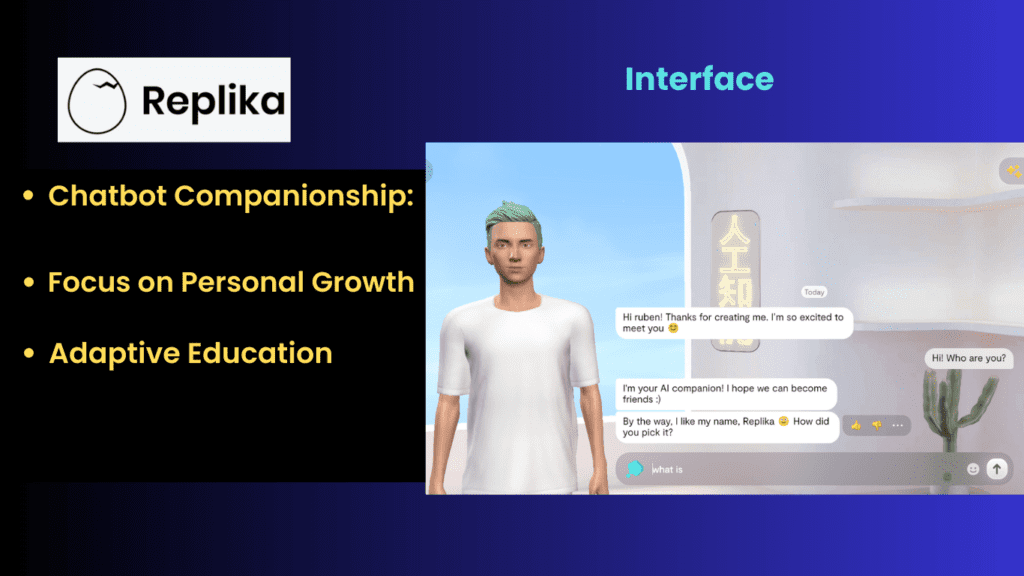
Replika is a unique platform in the artificial intelligence space that aims to improve conversational experiences. Replika AI tools explore the nuances of natural language processing and are intended to mimic human-like interactions. This allows users to have a conversation partner that is both engaging and unique.
Feature
- Chatbot Companionship: The core feature of Replika’s services is its advanced chatbot technology, which gives customers a conversational companion that changes and grows with every exchange. Replika’s chatbot facilitates meaningful conversations between users, whether they are seeking companionship or self-reflection.
- Focus on Personal Growth: Replika is unique in that it places a strong focus on personal development. The AI tools are intended to be a helpful guide on the path of self-discovery, encouraging users to explore their ideas, emotions, and goals.
- Adaptive Education: Replika AI tools use adaptive learning algorithms, which are constantly evolving to better understand and meet users’ unique conversational styles. This flexibility makes interactions more dynamic and personalized.
Conclusion
In summary, there is a wide range of dynamic artificial intelligence tools available, each with specific functions and uses. Chat GPT is a potent conversational language model that stands out among the top 10 AI tools listed, demonstrating the amazing powers of natural language processing.
This extensive list includes contributions from Google Bard, TensorFlow, Rasa, H2O.ai, Microsoft Azure, Caffe, PY Torch, Paradox, and Replika, which span a variety of AI applications from conversational agents to deep learning frameworks. These tools, which provide creative
Solutions in a range of domains are essential in influencing the direction artificial intelligence will take as technology develops.
Is ChatGPT Faster Than Google?
Google stands out in terms of speed and reach. Unlike ChatGPT, one can access multiple sources with a single query.
Who Created ChatGPT?
OpenAI is the creator of ChatGPT. Ilya Sutskever, Greg Brockman, John Schulman, and Wojciech Zaremba co-founded OpenAI; Sam Altman later joined as CEO. The OpenAI research and engineering team, under the direction of Dario Amodei and Ilya Sutskever, is responsible for creating ChatGPT.
Can I Use AI For Free?
Yes, depending on the particular tool and its intended use case, the majority of the AI tools we mentioned can be used for personal projects.
What is The Strongest Type of AI?
Strong AI, or general AI, is able to understand and learn any logical work that a human can. It enables a machine to use expertise and abilities in various situations.

